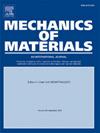A rate-dependent implicit gradient damage model with energy limiter: Ductile fracture analysis and determination of the physical length scale
IF 3.4
3区 材料科学
Q2 MATERIALS SCIENCE, MULTIDISCIPLINARY
引用次数: 0
Abstract
This work presents an implicit gradient-enhanced damage theory for failure in elastoplastic solids under the quasi-static loading condition. Our previous rate-independent gradient-enhanced damage formulation based on the energy limiter concept for brittle fracture in (Tran, Bui et al, CMAME 413:116123, 2023) is extended to ductile damage analysis with the consideration of rate-dependent crack growth characteristics. The present development contains a system of equilibrium and rate-dependent gradient crack evolution equations that describe the deformation of the body and rate-dependent evolution of the smeared damage in metals, respectively. For the nonlocal damage law, it has almost the same form as the one in our mentioned reference, except for the introduced rate-dependent crack growth term. Consistently with the energy limiter idea for fracture analysis, the material constitutive elastoplastic stress–strain relation is derived from the energy limiter formulation developed for ductile crack growth modeling with the von Mises plasticity criterion for an isotropic body under the small strain regime. This study, other than numerical experiments, will present a complete procedure to determine all input parameters used in the current theory for ductile failure analysis including the value of the length scale from reference experimental tests. To the best knowledge of the authors, it will show, for the first time in the literature, that the length scale is an actual physical scalar of the simulated problem and could be estimated from experiments. On the numerical side, ductile failure analyses under the standard finite element method (FEM) with the aid of an iterative staggered algorithm with both two-dimensional (2D) plane strain and general three-dimensional (3D) crack-growth problems are conducted to reveal the performance and capability of the gradient damage formulation based on the energy limiter concept for fracture in metals.
带能量限制器的速率依赖隐式梯度损伤模型:韧性断裂分析及物理长度尺度的确定
本文提出了准静态加载条件下弹塑性固体破坏的隐式梯度增强损伤理论。我们之前基于(Tran, Bui等,cmm 413:116123, 2023)脆性断裂能量限制概念的速率无关梯度增强损伤公式,扩展到考虑速率相关裂纹扩展特性的延性损伤分析。目前的发展包含一个平衡和速率相关的梯度裂纹演化方程系统,分别描述了体的变形和金属中涂抹损伤的速率相关演化。对于非局部损伤规律,除了引入了与速率相关的裂纹扩展项外,其形式与我们提到的文献几乎相同。与断裂分析的能量限制器思想一致,材料本构弹塑性应力-应变关系由基于von Mises塑性准则的小应变状态下塑性裂纹扩展模型的能量限制器公式推导而来。除了数值实验之外,本研究将提供一个完整的程序来确定当前理论中用于延性破坏分析的所有输入参数,包括参考实验测试的长度尺度值。据作者所知,它将在文献中首次表明,长度尺度是模拟问题的实际物理标量,可以从实验中估计出来。在数值方面,结合二维平面应变和一般三维裂纹扩展问题,采用迭代交错算法对标准有限元法进行了延性破坏分析,揭示了基于能量限制概念的梯度损伤公式在金属断裂中的性能和能力。
本文章由计算机程序翻译,如有差异,请以英文原文为准。
求助全文
约1分钟内获得全文
求助全文
来源期刊

Mechanics of Materials
工程技术-材料科学:综合
CiteScore
7.60
自引率
5.10%
发文量
243
审稿时长
46 days
期刊介绍:
Mechanics of Materials is a forum for original scientific research on the flow, fracture, and general constitutive behavior of geophysical, geotechnical and technological materials, with balanced coverage of advanced technological and natural materials, with balanced coverage of theoretical, experimental, and field investigations. Of special concern are macroscopic predictions based on microscopic models, identification of microscopic structures from limited overall macroscopic data, experimental and field results that lead to fundamental understanding of the behavior of materials, and coordinated experimental and analytical investigations that culminate in theories with predictive quality.
 求助内容:
求助内容: 应助结果提醒方式:
应助结果提醒方式:


